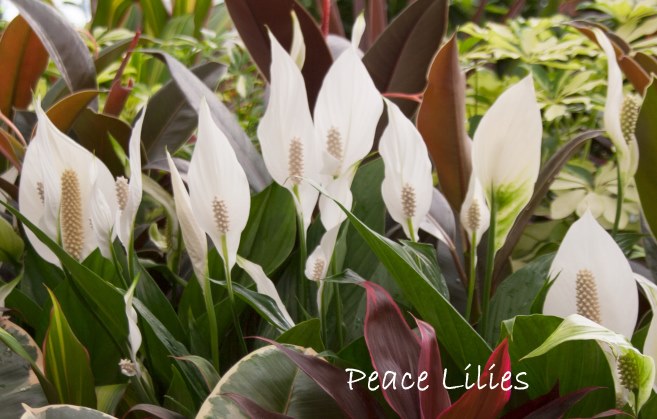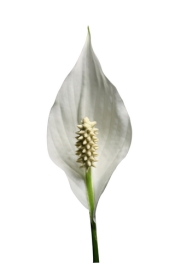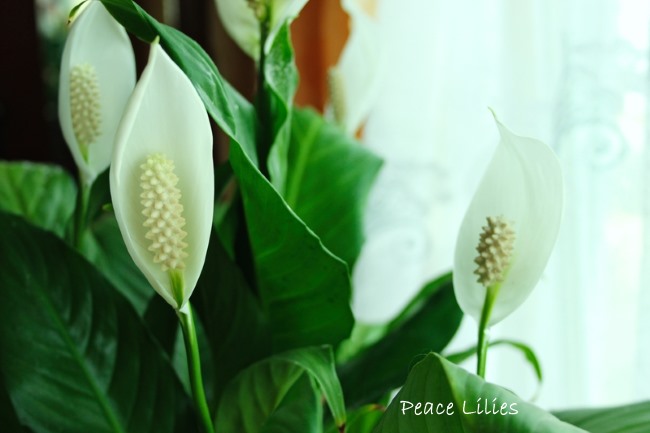Peace Lily Care
Botanical Name: Spathiphyllum wallisii
Of all the flowering house plants, Peace Lily care is probably the easiest. In fact, it tolerates average indoor conditions better than many house plants.
It's good for you, too. This is one of the best plants for improving air quality indoors. Spathiphyllum has one of the top removal rates of toxins such as formaldehyde, ammonia and carbon monoxide from tainted indoor air.
 Of all the flowering houseplants, peace lilies may be the easiest and longest lasting.
Of all the flowering houseplants, peace lilies may be the easiest and longest lasting.Get to Know Peace Lily Plant
Blooms usually appear in early summer and last for weeks. Each spoon-shaped spathe is pristine white and surrounds the protruding spadix that is densely covered by its tiny, true flowers.
When flowers start to fade, cut off the flower stalks as close to the base as possible.

No blooms? Plants that fail to bloom usually aren't getting enough sunlight. Move your plant to a brighter location, but keep it out of direct sun, which can scorch leaves. Got an older plant that refuses to bloom? If you haven't divided it in several years, divide it in spring. This is one of the few plants I know that blooms better after dividing it.
Dark-green, glossy leaves are strongly veined and arch away from the plant's base, making this an attractive foliage plant when not in bloom. Keep its leaves dust-free by wiping them with a damp cloth.
Over time, peace lilies will slowly grow offsets. You can keep them together in the same pot for a lush, full display. Or you can divide the offsets and pot them separately.
Spathiphyllum Problems, Solutions and Answers
When caring for peace lily plants, remember that its leaves will indicate any problems.
Brown leaf tips? Brown leaf tips are likely caused by overwatering. Water thoroughly, but don't allow the soil to get soggy. It could also be caused by direct sun. Move it to a shadier spot and be careful not to overwater.
Dry, crunchy leaves? If the leaves become shriveled and dry, the humidity is too low. You can increase humidity by misting the plant, placing it on a tray of wet pebbles or set it near a cool-mist room humidifier.
Yellow edges on leaves are a sign that the potting mix is too dry or it lacks fertilizer. See "Fertilizer" tips below.
Drooping stems may indicate that the plant is thirsty; however, wilting can also be a symptom of over-watering. Use a pot with drainage holes to avoid soggy potting mix.
Curled leaves? Too much sun. These beauties can't take hot, direct sunlight.
Something bugging your plant? Thrips are tiny, narrow insects that may feed on peace lilies. Thrips feed on plant juices, leaving streaks on foliage that may pucker or curl. Feeding on flowers, they cause dark spots or blotches. Isolate any infested houseplant to prevent pests from invading other indoor plants. Try washing thrips off plants with a spray of water. If the infestation is severe, or you have some stubborn bugs, spray the plant with insecticidal soap.
Is Spathiphyllum poisonous? Yes -- according to the ASPCA, peace lily contains insoluble calcium oxalates, which causes intense burning in the mouth. Keep it away from children, cats and dogs who may play with or chew on it, and wash hands thoroughly after handling it.
 Indirect light near a window is ideal to coax peace lilies to bloom. Photo © Dolotova1992
Indirect light near a window is ideal to coax peace lilies to bloom. Photo © Dolotova1992Varieties of Peace Lilies
There are many good cultivars to choose from. Here are a few...'Mauna Loa' is a beautiful and long-time favorite. 'Sensation' is a popular floor plant, reaching 6 ft (1.8 m) tall. A newer cultivar that's getting attention is 'Domino' with marbled green and white foliage. 'Petite' is a small variety, ideal for a dish garden.
Peace Lily Care Tips

Origin: South America
Height: Most varieties reach about 3 ft (90 cm)
Light: Bright light, but no direct sun. Peace lilies will tolerate low light, but may not bloom. Brown scorch marks on leaves, as well as curled leaves, are signs of too much sunlight.
Water: Keep soil evenly moist. Use a pot with a drainage hole to prevent soggy soil, which can cause root rot. Always use room-temperature water for your houseplants; cold water is a shock to them.
Humidity: Relative humidity of 40% or higher. Shriveled, dry leaves are likely caused by dry air. Indoor humidity can drop drastically in winter and may need a boost. Take a look at these easy ways to increase humidity for your houseplants.
Temperature: Average room temperatures (65-75°F/18-24°C) year-round. Protect your plant from cold drafts near entryways, as well as AC vents.
Soil: Peat moss-based potting mix
Fertilizer: Feed monthly in spring and summer with a balanced houseplant fertilizer that includes micronutrients, using half the recommended strength. Yellow edges on leaves indicate a deficiency of magnesium and iron.
Propagation: Division of offsets. Early spring is the best time to divide Spathiphyllum because it is beginning its most vigorous time of growth. Divide it every 5 years or when necessary.


